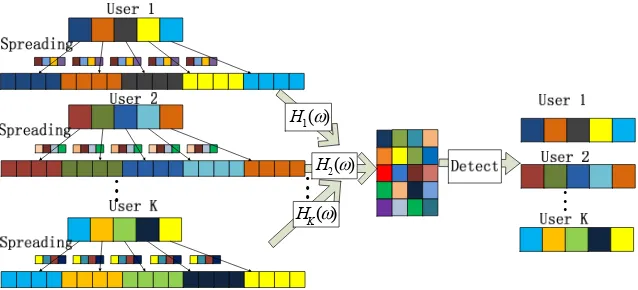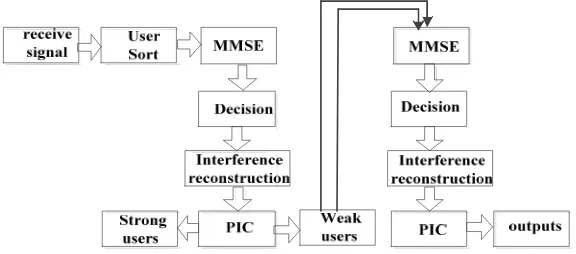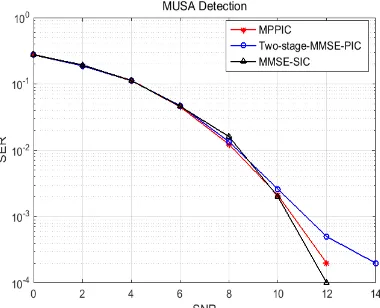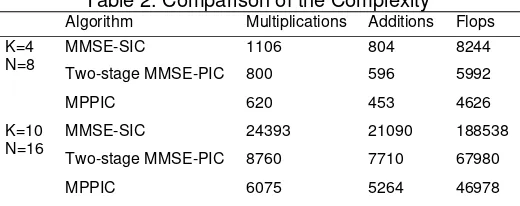DOI: 10.12928/TELKOMNIKA.v14i4.4052 1390
Multi-Stage Partial Parallel Interference Cancellation
Algorithm for MUSA Systems
Yan Liang, Han Wu*, Guangyu Wang
Chongqing Key Laboratory of Mobile Communication Technology
Chongqing University of Posts and Telecommunications (CQUPT), Chongqing, 400065, China *Corresponding author, e-mail: [email protected]
Abstract
Multi-User Shared Access is a non-orthogonal multiple access scheme of 5G,which has a high computational complexity and a large time delay due to the usage of successive interference cancellation detection algorithm. This paper proposes a multi-stage partial parallel interference cancellation detection algorithm, which does not require repeated ordering and repeated matrix inversion. In the first stage of detection, the bits of these users with good channel conditions will be outputted, and the influence of multiple access interference on users with bad channel conditions in the second stage will be decreased. Theoretical analysis and simulation results show that the symbol error rate of the proposed algorithm is slightly better than that of the two-stage MMSE-PIC, and the complexity is reduced. In the meanwhile, the computational complexity is significantly reduced without SER performance degradation when compared with MMSE-SIC algorithm.
Keywords: Multi-User Shared Access, non-orthogonal multiple access, successive interference cancellation, parallel interference cancellation, symbol error rate
Copyright © 2016 Universitas Ahmad Dahlan. All rights reserved.
1. Introduction
In the mobile communication system [1], multiple access technique is to allow users to share the scarce radio resources and communicate simultaneously. From the first to the fourth generation mobile communication, FDMA, TDMA, CDMA and OFDMA are used as the main multiple access schemes, all of them are orthogonal multiple access. However, in order to meet the demands of massive connections, high spectrum efficiency, and high capacity and low latency [2-3] of the fifth generation mobile communication [4-5], non-orthogonal multiple access has attracted a lot of considerations. So far, there are three well-known proposals in the community of non-orthogonal multiple access schemes in China: ZTE Corporation proposes Multi-User Shared Access (MUSA) [6], which achieves free scheduling transmission; Sparse Code Multiple Access (SCMA) [7] from Huawei Corporation, has realized the channel overload by 300%; Pattern Division Multiple Access (PDMA) [8], supported by Datang Telecom, reduces the realization complexity.
The key elements of MUSA system include complex multi-domain spreading codes [9-10] and advanced successive interference cancellation (SIC) receiver [11]. The spreading codes among various users are non-orthogonal in MUSA system, therefore the performance of the MUSA systems will be mainly affected by multiple access interference (MAI), also including multipath interference and noise. In order to meet the requirements of the fifth generation mobile communication such as massive connections, high spectrum efficiency, high capacity and low latency, how to increase the capacity and eliminate the MAI are major challenges for MUSA systems.
computation e.g. matrix inversion due to the MMSE criterion. Unfortunately, the user number decide the number of iterative procedures, therefore the MMSE-SIC detection algorithm result in a high complexity and a large processing delay of the system when the user number is getting large. As is well-known, the classical MMSE-PIC algorithm, which has been widely used in CDMA and MIMO systems, has several characteristics such as low computational complexity and a small delay. In general, the MMSE-PIC algorithm requires multi-stage structure, and detects all users’ signals in parallel. However at the case of parallel processing, those stronger users always influent weaker users, which raise the impact of MAI. In terms of the shortcomings of the MMSE-SIC and the traditional MMSE-PIC algorithm, a multi-stage partial parallel interference cancellation algorithm is proposed, which only needs once ordering and the number of matrix inversion with respect to the MMSE-SIC has significantly reduced. Theoretical analysis and simulation results show that the complexity of the proposed detection algorithm is significantly reduced without SER performance degradation when compared with MMSE-SIC algorithm.
2. System Model
Figure 1 describes the uplink MUSA system architecture. Assuming that there are K users, each user’s data are spread by dedicated complex multi-domain spreading codes respectively. Then all spread symbols are transmitted over the same time-frequency resources.
1( )
H
2( ) H
( )
K
H
Figure 1. Uplink MUSA System
The received signal after the channel can be represented by:
1
K
k k k k
r
g s x
z
=. (1)
Where
x
kis the transmitted symbol of user k,s
kis the spreading sequence of user k,g
kis the channel gain of user k, and z is a complex-valued noise taken from a zero mean Gaussian distribution with variance
2.The received signal can be rewritten by vector as:
r
Hx
z
(2)Where r ( ,r r1 2, ,rN )T ,
( ,
1 2,
,
)
T K
x
x x
x
,z
( ,
z z
1 2,
,
z
N)
T, 2~
(0,
)
z
CN
I
.H
3. Multi-user Detection Algorithm 3.1. MMSE-SIC Detection Algorithm
The MMSE-SIC algorithm is based on the scheme of successive processing, which eliminates inter-interference step by step, and each step only detects one user. Therefore, if there are K users in the system, there should be K time’s detections. Figure 2 shows the structure of the MMSE-SIC.
~ ~
1 1 1
y y h x
~ ~ ~
2 2
2 1
y y h x
~ ~ ~
3 3
3 2
y y h x
~ 3 y ~ 2 y ~ 1 y
~ 2 x ~ 1 xFigure 2. MMSE-SIC Structure
The main steps of the MMSE-SIC algorithm are as follows:
Step 1: Initialization
1 1
1, ,
i r r H H
H 2 1 H
(
G H H σ I) H
Step 2: SIC
For i=1: K Ordering:
1 1
{ , , }
arg m ax( )
i
i j
j k k
k SIN R
Nulling vector:
( )
i i
k k
ω
G
Nulling:
i i
k k i
y
ω
r
Hard decision:
~
( ) i i
k k
x Q y
SIC:
~
1
( )
i ii i k k
r
r
H
x
Update the channel matrix:
~
1 ( ) i i
i i k k
r r H x
Calculate the weight matrix: H 2 1 H
1 ( 1 1 σ ) 1
i i i i
G H H I H
End
Where Q(.) and I respectively denote the quantization (slicing) operation and identity matrix,
i
k
H
denotes the matrix generated by deleting the k-th column of H. (H)kdenotes the k-column of
H
. H denotes the Frobenius norm of matrixH
. The SINR is given by:2 i
2 2 2
i l i
i i
l i
G h SINR
G h
G
There will be K time’s matrix inversion and K-1 times ordering and when there are K users in the system, therefore, the complexity is high and the delay is large. As for the demands of massive connection of 5G, those will be worse.
3.2. Proposed Algorithm
The proposed MPPIC algorithm mainly adapts two stages MMSE-PIC construction instead of MMSE-SIC because of consideration of complexity and processing delay. Compared with traditional MMSE-PIC, proposed algorithm divide first stage detected users into two groups, stronger users will be outputs and weaker users will be passed to next stage detection. In general, users are sorted in ascend order according to their channel states, then MMSE-PIC algorithm is adopted in the first-stage detection. Interference of all users will be reconstructed according to the outputs of the first-stage detection and the channel estimation, and then the bits of these stronger users will be outputted. Final, the remaining users are detected again with the MMSE-PIC algorithm. Figure 3 presents the schematic diagram of the proposed algorithm.
Figure 3. The Schematic Diagram of the Proposed Algorithm
The main steps of the two-stage partial parallel interference cancellation algorithm are as follows:
Step 1: Initialization
H 2 1 H
( σ ) (M M S E )
G H H I H
~ ~ ~
1
[ (0),..., K(0)]
xGr x x
Ordering:
k
i
arg max
H
iStep 2: the first-stage PIC
For k=1: K
^ ~ ~ ~ ~
1
1 1
[ (0),
,
(0), 0,
k(0),
,
K(0)]
k k
x
x
x
x
x
PIC:
^
k k
r
r
H x
Hard Decision: ~
(1)
(
)
k k k
x
Q H r
End
Step 3: the second-stage PIC
The number of matrix inversion and user ordering is significantly reduced when compared with MMSE-SIC algorithm, especially when the number of users is large. In addition, as the PIC detector [12] adopts the interference cancellation in parallel, and the influence caused by the others users is always existed, which affects the performance of the system. While the proposed algorithm outputs the stronger users in the first stage, which in return reduce the MAI of the weaker users in the second stage.
The proposed algorithm is similar to the traditional detection algorithm, two-stage MMSE-PIC []. However, the main difference is that the proposed algorithm outputs the stronger users in the first detection stage, which reduce the MAI of the weaker users in the second detection. While the traditional two-stage MMSE-PIC does not output signals in the first stage, and the MAI which is caused by these stronger users has a large influence on these weaker users. In addition, the influence is always existed, thus the weaker users will suffer large MAI in the second detection. Therefore, there will be performance loss when using the traditional two-stage MMSE-PIC algorithm. What’s more, as the stronger users are outputted in the first two-stage, which in return reduce the complexity of the proposed algorithm.
4. Performance and Complexity Analysis
In this section, the performance and complexity of the proposed algorithm are discussed. For convenience, the proposed algorithm is labeled as MPPIC. Simulation parameters are as shown in Table 1. The length of spreading codes is N, and the number of users is K.
4.1. Performance Analysis
In this subsection, the symbol error rate (SER) performance of the proposed algorithm, two-stage MMSE-PIC and MMSE-SIC algorithm is compared. Figure 4 and Figure 5 show the SER performance results of the three algorithms with different number of users and different length of spreading codes. The others parameters are shown in Table 1.
Figure 4. SER Performance of the three Algorithm for N=8, K=4
Figure 5. SER Performance of the Three Algorithm for N=16, K=10
Table1. Simulation Parameters
Parameters Value N
K
Channel model Channel Estimation SNR
Modulation
8,16 4,10 Rayleigh fading channel
Ideal 0-14dB
As are shown in Figure 4 and Figure 5, the SER performance of the MPPIC algorithm is comparable to the MMSE-SIC, but it is better than that of the two-stage MMSE-PIC, with the change of K and N, which is due to the received signal through the MMSE detector first, and the MMSE detector makes a compromise between noise and MAI. What’s more, the stronger users have been outputted in the first detection stage, which reduce the MAI of the weaker users in the second stage. Thus, the weaker users have more accurate detection, which in return improves the system performance.
4.2. Complexity Analysis
The complexity of the three algorithms is analyzed in this subsection, we consider all complex multiplications/divisions and complex additions/subtractions and use floating point operation (flop) as unit to measure complexity. One multiplication and one addition respectively correspond to 6 flops and 2 flops [13].
For a
m n
channel matrix, the calculation of the weight matrix of MMSE requires 2 25 2
n m n
mn
multiplications and5 2
n m
2
3 2
n
2
2
mn
3 2
n
additions [14].Table 2. Comparison of the Complexity
Algorithm Multiplications Additions Flops K=4
N=8
MMSE-SIC 1106 804 8244 Two-stage MMSE-PIC 800 596 5992
MPPIC 620 453 4626 K=10
N=16
MMSE-SIC 24393 21090 188538 Two-stage MMSE-PIC 8760 7710 67980
MPPIC 6075 5264 46978
Table 2 shows the complexity of the three algorithms with different N and K. The MMSE-SIC has the highest complexity and the proposed algorithm has the lowest complexity. The complexity of the MMSE-SIC increases sharply with the increase of N and K, while the complexity of the MPPIC is increased relatively slow.
As the MMSE-SIC algorithm involves K-1 times ordering and K times matrix inversion when there are K users access to the system, while the proposed algorithm only requires once ordering and two times matrix inversion , and the matrix inversion has a large complexity. What’s more, stronger users are outputted in the first detection stage, which reduce the complexity when compared with that of the two-stage MMSE-PIC. Therefore, MMSE-SIC has the largest complexity, while the proposed algorithm has the lowest complexity, especially when the number of access users is large in the massive connection scenario of 5G.
5. Conclusion
Acknowledgements
This work is supported by National Science and Technology Major Project of China (2016ZX03001010) and the Science and Technology Research Project of Chongqing Municipal Education Commission of China (KJ1400437).
References
[1] David Tse, Pramod Viswanath. Fundamentals of Wireless Communication. Cambridge University Press. 2005.
[2] Zhao Guofeng, Chen Jing, Han Yuanbing. Prospective network techniques for 5G mobile communication: A survey. Journal of Chongqing University of Posts and Telecommunications (Natural Science Edition). 2015; 27(4): 441-452.
[3] Y Yifei, Z Longming. Application scenarios and Enabling Technologies of 5G. Communications. 2014; 11(11): 69-79.
[4] IMT-2020(5G) Promotion Group. 5G vision and demand. 2014; 5.
[5] You Xiaohu, Pan Zhiwen, Gao Xiqi, et al. The 5G mobile communication: the development trends and its emerging key techniques. SCIENCE CHINA Information Sciences. 2014: 44(5): 551-563. [6] Yuan Zhifeng, Yu Guanghui, Li Weixing. Multi-User Shared Access for 5G Wireless Networks.
Network Technology. 2015; (5): 28-31.
[7] H Nikopour, H Baligh. Sparse Code Multiple Access. IEEE International Symposium on PIMRC. 2013: 332-336.
[8] Kang Shaoli, Dai Xiaoming, Ren Bin. Pattern Division Multiple Access for 5G Wireless Networks. 2015; (5): 43-47.
[9] Tao Yunzheng, Liu Long, Liu Shang, et al. A survey: Several technologies of non-orthogonal transmission for 5G. Communications. 2015; 12(10): 1-15.
[10] Wang Bichai, Wang Kun, Lu Zhao Hua, et al. Comparison study of Non-OrthogonalMultiple Access schemes for 5G. IEEE International Symposium on Broadband Multimedia Systems and Broadcasting. 2015: 1-5.
[11] Farzad Moazzami. Successive Co-Channel Interference Cancellation. Indonesian Journal of Electrical Engineering and Informatics (IJEEI). 2015; 3(1): 34-38.
[12] Ahmed El-sayed Ei-Mahdy, Maged Ahmed. Low Complexity Selective Adaptive Multicarrier DSCDMA Receiver. TELKOMNIKA Telecommunication Computing Electronics and Control. 2013; 2: 321-330. [13] Wu Kai, Sang Lin, Wang He, et al. Detection Algorithm for V-BLAST Systems with Novel Interference
Cancellation Technique. IEEE Vehicular Technology Conference. 2009: 1-5.



